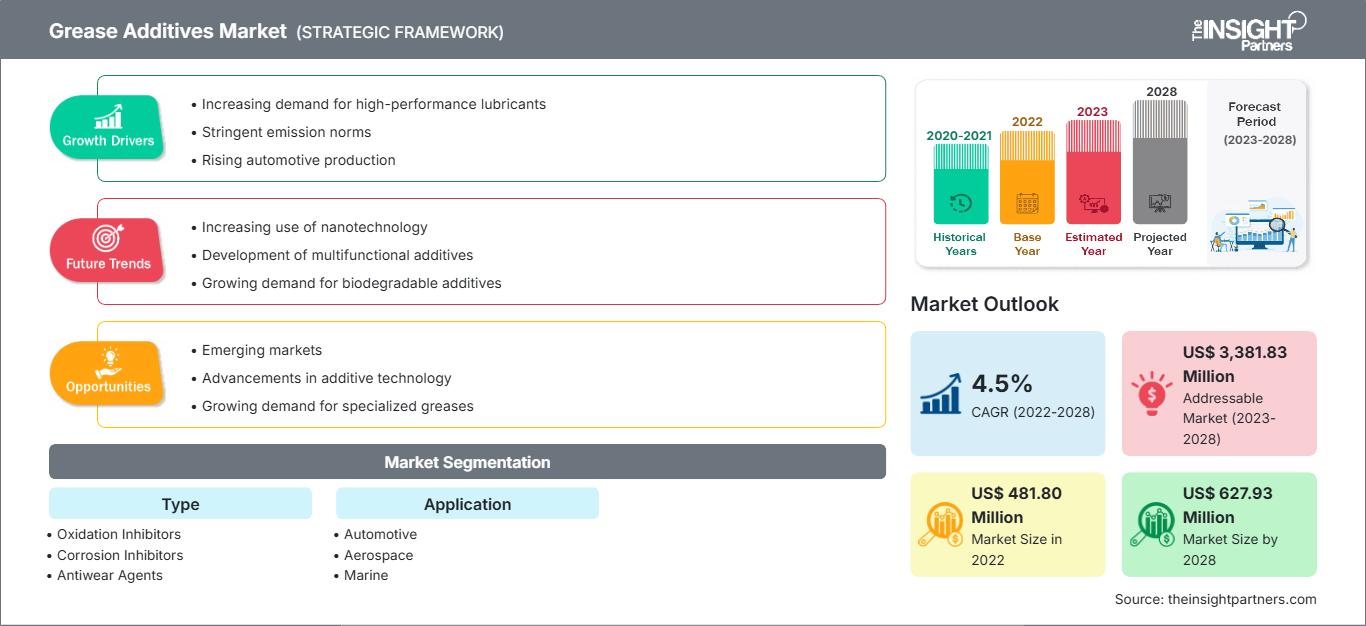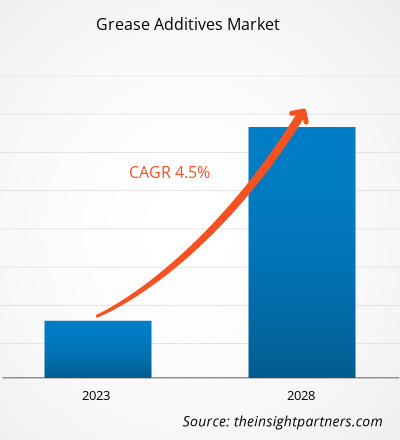[Forschungsbericht] Der Markt für Schmierfettzusätze hatte im Jahr 2022 ein Volumen von 481,80 Millionen US-Dollar und soll bis 2028 627,93 Millionen US-Dollar erreichen; von 2022 bis 2028 wird mit einer durchschnittlichen jährlichen Wachstumsrate von 4,5 % gerechnet.
Schmierfettzusätze sind organische oder anorganische Chemikalien, die als Feststoffe in Öl gelöst oder suspendiert sind. Ein Anstieg der Pkw- und Nutzfahrzeugverkäufe treibt den Markt für Schmierfettzusätze an. Schmierfettzusätze werden in Schmierfetten verwendet, um die Leistung von Geräten zu verbessern und ihre Lebensdauer zu verlängern.
Industriefette bestehen hauptsächlich aus Grundöl, Verdickungsmittel und Additiven; Additive sind nach dem Grundöl die zweitwichtigste Komponente. Bei der Fettherstellung werden drei Arten von Grundölen verwendet: Mineralöl, Pflanzenöl und synthetisches Öl. Synthetische Fette werden aus synthetischen Ölen wie Polyalphaolefin hergestellt. Sie werden häufig im industriellen Sektor eingesetzt, insbesondere in der Automobilindustrie. Ihre überlegenen Eigenschaften, ihre Fähigkeit, Betriebskonsistenz zu gewährleisten, und ihre erschwinglichen Kosten machen sie zu einer bevorzugten Kategorie von Schmiermitteln. Synthetische Fette werden in Anwendungen mit extremen Temperaturen, Belastungen und Geschwindigkeiten eingesetzt. Additive für synthetische Fette verbessern die physikalischen und chemischen Eigenschaften, indem sie den Viskositätsindex erhöhen, die Flüchtigkeit verringern und den Pourpoint von Schmiermitteln senken. Viskositätsindexverbesserer, Pourpointerniedriger, Dispergiermittel und Detergenzien sind einige der weit verbreiteten Kategorien von Additiven. Mit der steigenden Nachfrage nach synthetischen Fetten wird der Bedarf an Additiven für diese Fette im Prognosezeitraum voraussichtlich stark ansteigen.
Mehrere große Marktteilnehmer entwickeln Additive für synthetische Fette, um deren Effizienz zu verbessern. So brachte Clariant im September 2022 Hochdruck-/Verschleißschutzadditive, Schmierfähigkeitsverbesserer, Korrosionsinhibitoren, Neutralisationsmittel und Leitformulierungen für vollsynthetische Metallbearbeitungsflüssigkeiten auf den Markt, die die Effizienz von Maschinen steigern. Mit der wachsenden Nachfrage nach synthetischen Fetten bringen die in diesen Fetten verwendeten Additive neue Trends auf den Markt für Fettadditive.
Im Jahr 2022 hielt der asiatisch-pazifische Raum den größten Anteil am Markt für Fettadditive und wird im Prognosezeitraum voraussichtlich die höchste durchschnittliche jährliche Wachstumsrate verzeichnen. Europa ist eine weitere attraktive Region und hält einen bedeutenden Marktanteil. Die zunehmende Installation von Onshore- und Offshore-Windkraftanlagen sowie die zunehmende Automobilproduktion tragen zum Wachstum des Marktes für Fettadditive in Europa bei. Schweden, Finnland, Deutschland und Frankreich verzeichnen einen deutlichen Anstieg bei der Installation von Windkraftanlagen, verbunden mit der steigenden Nachfrage nach erneuerbaren Energien. Laut WindEurope VZW/ASBL verzeichnete Europa im Jahr 2022 19,1 GW an neuen Windkraftanlagen, darunter ca. 16,7 GW Onshore- und 2,5 GW Offshore-Projekte. Fett wird verwendet, um die Leistung von Windkraftanlagen zu verbessern, da es die Beständigkeit gegen Korrosion, Hitze, Wetter und Flammen erhöht.
Passen Sie diesen Bericht Ihren Anforderungen an
Sie erhalten kostenlos Anpassungen an jedem Bericht, einschließlich Teilen dieses Berichts oder einer Analyse auf Länderebene, eines Excel-Datenpakets sowie tolle Angebote und Rabatte für Start-ups und Universitäten.
Markt für Fettzusätze: Strategische Einblicke

-
Holen Sie sich die wichtigsten Markttrends aus diesem Bericht.Dieses KOSTENLOSE Beispiel umfasst Datenanalysen, die von Markttrends bis hin zu Schätzungen und Prognosen reichen.
Auswirkungen der COVID-19-Pandemie auf den Markt für Schmierfettzusätze
Die COVID-19-Pandemie beeinträchtigte Volkswirtschaften und Industrien in mehreren Ländern weltweit. Lockdowns, Reisebeschränkungen und Betriebsschließungen in Nordamerika, Europa, im asiatisch-pazifischen Raum (APAC), Süd- und Mittelamerika sowie im Nahen Osten und Afrika (MEA) bremsten das Wachstum mehrerer Branchen, darunter Automobilindustrie, Bauwesen, Luft- und Raumfahrt und Bergbau. Die Schließung von Produktionseinheiten störte globale Lieferketten, Fertigungsaktivitäten, Lieferpläne sowie den Verkauf lebenswichtiger und nicht lebenswichtiger Produkte. Verschiedene Unternehmen erlebten 2020 Verzögerungen bei Produktlieferungen und einen Einbruch der Produktverkäufe. Darüber hinaus zwangen die von den Regierungen verschiedener Länder in Europa, im asiatisch-pazifischen Raum und in Nordamerika verhängten Reiseverbote die Unternehmen dazu, ihre Kooperations- und Partnerschaftspläne vorübergehend einzustellen. All diese Faktoren behinderten verschiedene Branchen im Jahr 2020 und Anfang 2021 und bremsten so das Wachstum mehrerer Märkte, darunter auch des Marktes für Schmierfettzusätze.
Während der Anfangsphase der COVID-19-Pandemie führten Lockdown-Beschränkungen und die Schließung von Produktionsstätten zu Produktionsausfällen und damit zu einer Lücke zwischen Angebot und Nachfrage. Diese Faktoren beeinträchtigten die Rentabilität verschiedener kleiner und großer Hersteller von Schmierfettzusätzen. Im Jahr 2021 nahmen mehrere Volkswirtschaften ihren Betrieb wieder auf, da die Regierungen verschiedener Länder Lockerungen der zuvor verhängten Beschränkungen ankündigten, was den globalen Markt ankurbelte. Die Hersteller durften mit voller Kapazität arbeiten, was ihnen half, die Lücke zwischen Angebot und Nachfrage sowie andere Auswirkungen zu überwinden. Die wachsende Nachfrage nach Automobil- und Industriemaschinen nach der COVID-19-Pandemie hat eine Nachfrage nach Schmierfettzusätzen erzeugt.
Markteinblicke
Strategische Entwicklungen wichtiger Akteure begünstigen das Wachstum des Marktes für Schmierfettzusätze
Wichtige Marktteilnehmer verfolgen verschiedene Marketingstrategien wie Produkteinführungen, Fusionen und Übernahmen sowie Kooperationen, die das Wachstum des Marktes fördern.
Typ-Einblicke
Basierend auf dem Typ ist der Markt für Schmierfettzusätze in Oxidationsinhibitoren, Korrosionsinhibitoren, Verschleißschutzmittel, Druckzusätze, Metalldeaktivatoren und andere unterteilt. Das Segment der Oxidationsinhibitoren hatte 2022 den größten Marktanteil. Das Segment der Druckzusätze wird im Prognosezeitraum voraussichtlich die höchste durchschnittliche jährliche Wachstumsrate verzeichnen. Das Wachstum des Marktes für Schmierfettadditive im Druckadditivsegment ist auf die steigende Nachfrage nach Schmierfetten in Anwendungen mit hohem Druck zurückzuführen, darunter in der Luft- und Raumfahrt, der Schifffahrt, im Bergbau und in Stahlwerken. Darüber hinaus unterstreicht der zunehmende mechanische Verschleiß in verschiedenen Anwendungen den Bedarf an effektiven Schmierfetten, ergänzt durch geeignete Schmierfettadditive.
Afton Chemical Corp, BASF SE, Clariant AG, Croda International plc, Evonik Industries AG, Shamrock Technologies Inc, The Lubrizol Corp, RT Vanderbilt Holding Co Inc, Lanxess AG und IPAC Inc gehören zu den wichtigsten Akteuren auf dem Markt für Schmierfettadditive. Diese Unternehmen konzentrieren sich hauptsächlich auf Produktinnovationen, um ihren Marktanteil zu vergrößern und neue Markttrends zu verfolgen.
Markt für Fettzusätze
Die Analysten von The Insight Partners haben die regionalen Trends und Faktoren, die den Markt für Schmierfettadditive im Prognosezeitraum beeinflussen, ausführlich erläutert. In diesem Abschnitt werden auch die Marktsegmente und die geografische Lage in Nordamerika, Europa, dem asiatisch-pazifischen Raum, dem Nahen Osten und Afrika sowie Süd- und Mittelamerika erörtert.Umfang des Marktberichts zu Fettzusätzen
| Berichtsattribut | Einzelheiten |
|---|---|
| Marktgröße in 2022 | US$ 481.80 Million |
| Marktgröße nach 2028 | US$ 627.93 Million |
| Globale CAGR (2022 - 2028) | 4.5% |
| Historische Daten | 2020-2021 |
| Prognosezeitraum | 2023-2028 |
| Abgedeckte Segmente |
By Typ
|
| Abgedeckte Regionen und Länder |
Nordamerika
|
| Marktführer und wichtige Unternehmensprofile |
|
Dichte der Marktteilnehmer für Fettzusätze: Verständnis ihrer Auswirkungen auf die Geschäftsdynamik
Der Markt für Schmierfettzusätze wächst rasant. Die steigende Nachfrage der Endverbraucher ist auf Faktoren wie veränderte Verbraucherpräferenzen, technologische Fortschritte und ein stärkeres Bewusstsein für die Produktvorteile zurückzuführen. Mit der steigenden Nachfrage erweitern Unternehmen ihr Angebot, entwickeln Innovationen, um den Bedürfnissen der Verbraucher gerecht zu werden, und nutzen neue Trends, was das Marktwachstum weiter ankurbelt.
- Holen Sie sich die Markt für Fettzusätze Übersicht der wichtigsten Akteure
Berichts-Spotlights
- Fortschreitende Branchentrends im Markt für Fettzusätze, die Unternehmen bei der Entwicklung effektiver langfristiger Strategien unterstützen
- Geschäftswachstumsstrategien der Akteure des Marktes für Fettzusätze in Industrie- und Entwicklungsländern
- Quantitative Analyse des Marktes von 2020 bis 2028
- Schätzung der weltweiten Nachfrage nach Fettzusätzen
- Porters Fünf-Kräfte-Analyse zur Veranschaulichung der Wirksamkeit von Käufern und Lieferanten im Markt für Fettzusätze
- Jüngste Entwicklungen zum Verständnis des wettbewerbsorientierten Marktszenarios
- Markttrends und -aussichten sowie Faktoren, die das Wachstum des Marktes für Fettzusätze fördern oder hemmen
- Unterstützung im Entscheidungsprozess durch Hervorhebung von Marktstrategien, die das kommerzielle Interesse untermauern
- Größe des Marktes für Fettzusätze an verschiedenen Knotenpunkten
- Detaillierte Übersicht und Segmentierung des Marktes und der Wachstumsdynamik der Fettzusätze Branche
- Größe des Marktes für Fettadditive in verschiedenen Regionen mit vielversprechenden Wachstumschancen
- Historische Analyse (2 Jahre), Basisjahr, Prognose (7 Jahre) mit CAGR
- PEST- und SWOT-Analyse
- Marktgröße Wert/Volumen – Global, Regional, Land
- Branchen- und Wettbewerbslandschaft
- Excel-Datensatz
Aktuelle Berichte
Verwandte Berichte
Erfahrungsberichte
Grund zum Kauf
- Fundierte Entscheidungsfindung
- Marktdynamik verstehen
- Wettbewerbsanalyse
- Kundeneinblicke
- Marktprognosen
- Risikominimierung
- Strategische Planung
- Investitionsbegründung
- Identifizierung neuer Märkte
- Verbesserung von Marketingstrategien
- Steigerung der Betriebseffizienz
- Anpassung an regulatorische Trends






















 Kostenlose Probe anfordern für - Markt für Fettzusätze
Kostenlose Probe anfordern für - Markt für Fettzusätze